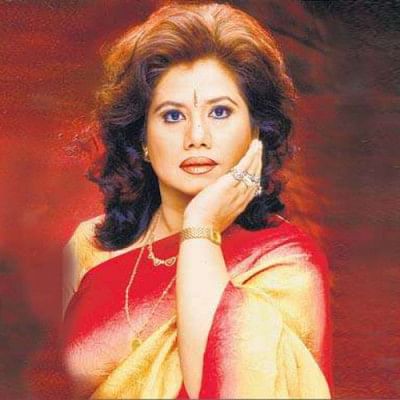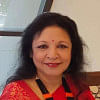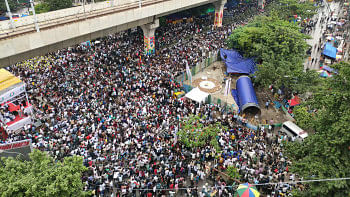Runa Laila is Runa Laila

This was the summer of 1990. I had taken a taxi cab to reach the Hawaii East West Centre in Hawaii, USA. I was selected by the centre to take part in a training titled 'Micro-computers in Demography.' Usually I would walk down to the centre to attend my early morning lectures, but on this particular occasion, I was running late. I hailed a cab and the cabbie seemed to be of Indian origin. As I took the ride, contemplating the charges for my tardiness, the cab driver asked me where I was from. Upon hearing my reply, he asked me if I knew Runa Laila and I answered, "Of course, everyone knows Runa Laila!"
I sort of expected him to be Indian (since he didn't look Bangladeshi, nor spoke Bangla), but he turned out to be a Pakistani. He explained that he was a neighbour of Runa Laila when she lived in Karachi as a young girl. He lamented about Pakistan losing this valuable singer.
I could easily recall Runa Laila during those years.
It was the election year of the 1970s. The last election of erstwhile East Pakistan. Pakistan TV gave overnight coverage to the election results. My grandmother allowed us to sleep on the drawing room floor and watch TV all night. There were four of us. We were two sisters and two other friends who were daughters of renowned writer Dilara Hashem. That was the first time I saw Runa Laila. I had already heard about her from Mithul (Dilara Hashem's daughter who lived in Karachi and also knew her).
Runa, then a slim bright-eyed teenager in an unusual outfit, appeared on Zia Mohiuddin's show. Zia Mohiuddin hosted a very interesting magazine programme and Runa was already a renowned singer and celebrity in Pakistan. She was asked to describe a remarkable moment in her singing career. Runa went on to explain how, during one of her vocal recordings, a fly entered her mouth and, to avoid a 'cut', she just went on with the recording. Runa looked eager, proud and very smart as she said, "For the sake of the programme, I digested the fly!"
Even when she made her early debut as a teenager in the realms of playback music in Pakistan, Runa landed into a difficult situation with the journalists who said that she was being haughty with the melody queen Noor Jehan. This matter was exaggerated and mentioned repeatedly in various newspapers and brought a lot of adverse publicity for Runa Laila. But her rise continued. Both in playback and stage performances, Runa Laila surpassed many boundaries. The range of her voice, her versatility with any branch of music, her flexibility with pronouncing difficult Punjabi, Sindhi and Pashtu songs (apart from Urdu ones) brought her immense fame and adoration.
She is one of the very few who translated the song into her body language and movement, and that too so aptly. The gestures and gyrations didn't just come out of her from nowhere. In one recent interview on Doordarshan TV, Bhupen Hazarika and Runa Laila were shown taking a stroll in a lavish garden of Calcutta where she told the audience the secret of her superb and well-coordinated movements. Runa Laila and her sister Dina Laila lived in Karachi. Runa, in her early years, was given training in Bharat Natyam and Dina learned music. For four years Runa took these lessons till her mother one day discovered that she had also memorised all the music lessons that Dina was taking! It was then that music training was initiated for her. In some of her songs, for example, "Ore tui bajash ne tore obujh bashi," recorded for BTV, a well-trained eye can easily spot her dexterous bharat natyam posture of playing the flute.
Since Runa returned to Bangladesh, she has been the subject of many discussions. She has run into various situations such as having to submit herself to the test audition for Bangladesh Radio! Her playback numbers in Bangla have topped many previous records both in the academic and commercial sense. She has been immensely applauded for her performance in India. She has recorded a wide range of songs from Nazrul to Bhawaiya, Bhajan and Ghazals. In a very short span of time, she became the most well-known Bangladeshi. Yes, one aspect has not gained enough attention, that is the fact that Runa has been the trend-setter. As far as performance is concerned, no Bangladeshi artiste has ever thought of show business as a performing art. Runa Laila presented her first performance for BTV in the mid-70s.
I myself was an intermediate student at that time and used to host a show on BTV called `Notun Kuri'. This programme gave me an opportunity to sample the on-going trend in the art of performance. As years went by, I noticed how young participants in that programme -- both from Dhaka and other places of the country -- adopted Runa Laila's style into their performance, rather than the sedate sitting down rendering with the self-accompaniment of a quaint harmonium.
Even many of the contemporary music luminaries are now emulating her. On today's private channels and also on BTV, we see the new generation of artists blending dance with their vocal performance. However, none has matched Runa because she has a special gift and in my opinion, her gift of presentation has made her the Queen in the sub-continent. On the occasion of Eid, ATN (Bangla) presented one of her shows where Runa has shown once again how she has utilised both her body rhythm and music training, and her imagination, to present each song with new dimensions. None can surpass the gifted Runa Laila. Runa Laila is a legend in her own right.
The writer is an academic, Nazrul exponent and writer.
For any queries, please contact
the author at [email protected]

 For all latest news, follow The Daily Star's Google News channel.
For all latest news, follow The Daily Star's Google News channel. 



Comments